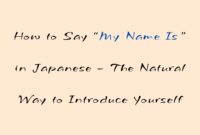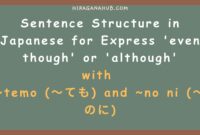Understanding the Dictionary Form of Verbs and the -MASU Form in Japanese
After learning about the classification of Japanese verbs in the previous
article, it’s time to discuss verb conjugation and changes in verb forms.
If you haven’t had a chance to read it yet, check out the article on
“Classification of Japanese Verbs.”
In Japanese, there are various types of verb conjugation, including the
dictionary form, the -MASU form, the -TE form, and more. In this article, we
will focus on changing verbs from the dictionary form to the -MASU form.
Before diving into how to change verb forms, let’s first understand what the
dictionary form and the -MASU form of verbs are!
What is the Dictionary Form of Verbs?
The dictionary form of verbs, also called じしょけい (jisho-kei) in Japanese,
is the basic form of a verb that you can find in the dictionary. Examples of
verbs in the dictionary form include “あるく” (aruku, to walk), “みる” (miru,
to see), “きく” (kiku, to ask), “たべる” (taberu, to eat), and so on. The
dictionary form is commonly used in informal situations, like when talking
with friends or family.
What is the -MASU Form of Verbs?
The -MASU form of verbs, or ますけい (masu-kei) in Japanese, is the polite
form of a verb. This form is used in more formal conversations, such as when
speaking with elders or people you’re not familiar with. The -MASU form is
usually one of the first verb forms taught to Japanese learners.
Now, let’s learn how to change verbs from the dictionary form to the -MASU
form!
How to Change the Dictionary Form of Verbs to the -MASU Form
Japanese verbs are divided into three groups, and the way they change depends
on their group.
1. Group 1: Verbs Ending in -U

For verbs in the first group, you simply change the ending -u to -i, then add
the -MASU ending.
Examples:
- “きく” (kiku, to ask) → “きき” (kiki) → “ききます” (kikimasu)
- “たつ” (tatsu, to stand) → “たち” (tachi) → “たちます” (tachimasu)
- “あるく” (aruku, to walk) → “あるき” (aruki) → “あるきます” (arukimasu)
It’s that simple!
2. Group 2: Verbs Ending in -RU

For verbs in the second group, simply remove the -RU ending and replace it
with -MASU.
Examples:
- “みる” (miru, to see) → “み” (mi) → “みます” (mimasu)
- “たべる” (taberu, to eat) → “たべ” (tabe) → “たべます” (tabemasu)
- “おきる” (okiru, to wake up) → “おき” (oki) → “おきます” (okimasu)
This step is very easy, as it only involves removing the -RU ending and
replacing it with -MASU.
3. Group 3: Irregular Verbs

Group 3 verbs do not follow the same rules as Groups 1 and 2. You need to
memorize the conjugation of these verbs as their changes are irregular.
Examples:
- “する” (suru, to do) → “します” (shimasu)
- “くる” (kuru, to come) → “きます” (kimasu)
- “あるく” (aruku, to walk) → “あるきます” (arukimasu)
Using the -MASU Form in Sentence Patterns
The -MASU form is the most frequently used verb form in Japanese sentences.
However, one important thing to remember is:
If the sentence pattern uses the -MASU form, the verb will appear without the
-MASU ending in its base form.
Examples:
- “たべます” (tabemasu) → “たべ” (tabe)
- “きます” (kimasu) → “き” (ki)
- “みます” (mimasu) → “み” (mi)
Understanding verb conjugation in Japanese takes time and practice. So, study
the changes step by step and don’t rush through it. The more you practice, the
easier it will become to remember and use the verb forms correctly.
That’s all for the explanation of the “Dictionary Form of Verbs and the -MASU
Form.” I hope this article helps you learn Japanese more effectively.
Thank you for reading! 🙂


